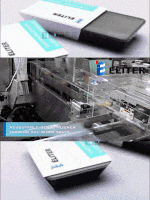Add Automation to your Manufacturing Processes, for Safety and Control
2022-12-13
Introduction to the novel way of adding automation to your manufacturing processes

Industrial automation does not only have a positive effect on improving production processes but also significantly improves the safety of employees. New technologies can minimize the chance of employees working in dangerous situations.
Overcoming Fears of Automation
Many workers are afraid of technological progress due to the generally accepted opinion that robots will replace people in their workplaces. But his fears are conjectures. According to a study published in 2017 by scientists from the universities of Oxford and Yale, AI experts predict a 50% chance that AI will surpass humans in all tasks within 45 years. But, instead of replacing all workers, there is a greater chance that AI will eliminate dangerous manual labor and develop other roles. We share some examples:
Automation in palletizing systems
Before automation-based solutions entered factories, workers had to do most of the work by hand. A system of work based on the strength of the human body, however, did not give good results. Workers quickly get tired, which leads to a decrease in their productivity. And over time, health problems related to the regular carrying of daily heavy loads also begin to appear. Today, robots are performing the work of moving, stacking and transporting products on pallets.
Automation of forging processes
Until recently, forging processes in the metallurgical industry were carried out with the help of human workers. Still today there are factories in which blacksmiths are responsible for putting the hot metal element under the hammer to form the final shape of the product. Such a device strikes with a force of several dozen tons, several times per minute. Therefore, being on the hammer is extremely dangerous and can cause permanent damage to the worker’s health. Elevated temperatures in the workplace can also have negative effects on the body.
In most companies, forging processes are now fully automated. Specially prepared robots for such work feed the elements to the automatic hammer with their tweezers. And sensory solutions help to make work safer by detecting the presence of people or undesirable elements inside the working machine. Quality control of manufactured products is also extremely important and is most easily controlled with an automated system.
Automation in welding processes
Welding processes are another dangerous activity in which automation is beginning to play a fundamental role. During welding work, toxic fumes are released from the gas coating, which the welder regularly inhales. This can lead to severe poisoning or chronic respiratory diseases. Welding also produces sparks that can cause severe burns and blindness to the worker.
Automation makes the process safer. There are high-quality welding machines on the market that can work continuously, under human control. With such solutions, it is necessary to use appropriate protective systems to protect employees from possible contact with machines during work. Automation in this situation eliminates a dangerous role and creates a new, safer working role.
Skillful design of automation systems
While factory automation eliminates some threats to workers, others often arise, which creates the need for strict design plans prepared by specialists in this field. It is necessary to prepare the automation system in such a way that it not only guarantees safety, but does so without reducing productivity or creating downtime that can cause the employee to bypass security systems. Systems that block the machine workspace should not interfere with the worker, and the worker should not interfere with the system. Whenever possible, instead of a mechanical lock, an optical curtain should be used at the power point to stop the operation of the machine if a foreign object interrupts the light beam of the curtain. Mechanical locks that block access to the workspace should be in places where it is not necessary to open the door often.

Successful human-machine collaboration
When designing automation systems at production enterprises, it is also necessary to remember that often a human works next to the robot. In palletizing systems, for example, one person is responsible for preparing the place for packing and cleaning the work area. In order for the work to go smoothly, it may be worthwhile to create two positions side by side. Mechanisms on the market today allow you to control the work of robots in a certain position, assigning them to the workspace. Special security scanners prevent robots from moving to positions where someone is working.




